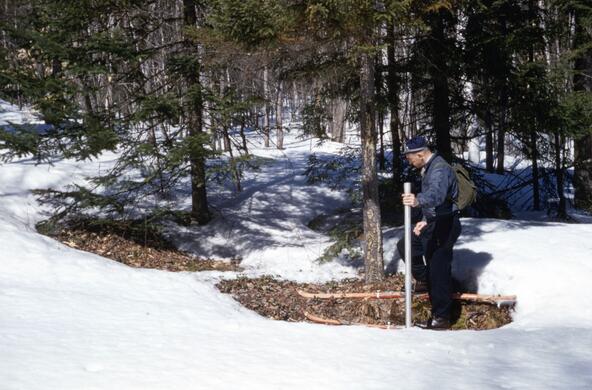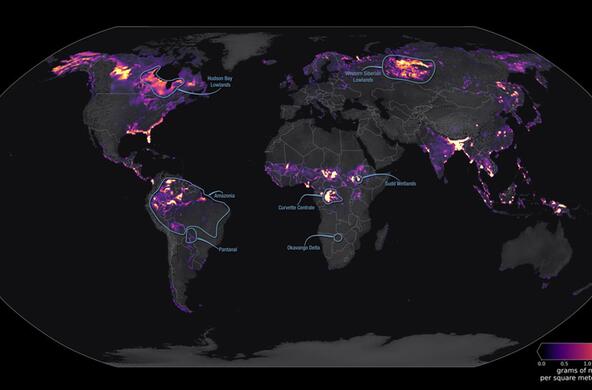Deduced from a variety of methods, the average rise in sea level has been about 1 to 2 mm/yr for the last 100 years, but recent rates are now ≥ 3 mm/yr and accelerating.
Measurements by the TOPEX/Poseidon satellite suggest that sea level rose at a rate of more than 3.3 mm/yr between 1993 to 2009, which is consistent with tide-gauge measurements during the same interval.
Observations of sea-level rise are complicated by continuing adjustments in the height of continents in response to the melting of ice from the last glaciation. Areas of subsidence show greater rates of sea-level rise, varying from 2 to 7 mm/yr along the eastern coast of the United States. In addition, over much of the oceans, the temperature of sea water has also risen over the last 100 years, so some of the rise in sea level—perhaps 0.6 mm/yr—must be attributed to the thermal expansion of water at warmer temperatures.
Some rise in sea level is likely due to the melting of mountain glaciers throughout the world—an indication of a global warming trend. The collective losses from mountain glaciers worldwide may exceed 335 km3/yr and account for 0.92 mm/yr of the total observed rise in sea level. The rest of the current rise in sea level is thought to be due to melting of the Greenland and Antarctic ice packs. Loss of the ice caps on Greenland and Antarctica was associated with a dramatic rise in sea level during past glacial cycles, and could account for as much as 50 cm of sea-level rise by 2050.
GRACE satellite measurements show that the ice pack on Greenland is in decline, and the melting on Greenland is consistent with observations of lower salinity in North Atlantic waters. The ice pack on Greenland shows the greatest decline at its margins and may actually be accumulating some mass in northern and interior regions. The recent net loss of ice on Greenland is estimated at 286 x km3/yr—contributing 0.78 mm/yr to the rise in sea level.
Overall, the massive ice cap on Antarctica shows smaller changes than in Greenland, but it also appears to be decreasing in volume. Rapid melting on the Antarctic Peninsula may be balanced by slight accumulations of snowfall in East Antarctica. Although the record is not long, measurements from GRACE show an accelerating loss of ice mass from Antarctica, now approaching 252 km3/yr. Declining salinity in the Ross Sea is consistent with these trends. The melting in Antarctica is thought to be responsible for 0.69 mm/yr of sea-level rise during the past decade.
The measured losses of ice volume from Greenland, Antarctica, and various mountain glaciers throughout the world yield a global rise in sea level of about 2.40 mm/yr, about 73% of the observed rate. Presumably the thermal expansion of warmer seawater explains the difference. By 2100, losses from these ice packs may yield a total sea level rise > 1 m, yielding widespread flooding of coastal environments and most of the world’s major cities. While these rates are alarming, they could be even higher. In total, the Greenland ice pack contains the equivalent of 7 m of sea level rise, whereas Antarctica contains about 65 m.
The market is not ripe for coastal real estate.
References
Chen, J.L., et al. 2013. Contribution of ice sheet and mountain glacier melt to recent sea level rise. Nature Geoscience 6: 549-552.
IMBIE Team. 2018. Mass balance of the Antarctic ice sheet from 1992 to 2017. Nature 558: 219-222.
Mouginot, J., et al. 2019. Forty-six years of Greenland ice sheet mass balance from 1972 to 2018. Proceedings National Academy of Sciences 116: 9239-9244.
NOAA. 2019. Sea-level rise viewer. https://coast.noaa.gov/slr/#/layer/slr/0/-7508745.611377318/5578481.336…
Nerem, R.S, et al. 2018. Climate-change-driven accelerated sea-level rise detected in the altimeter data. Proceedings National Academy Sciences 115: 2022-2025.
Piecuch, C. G., et al. 2018. Origin of spatial variation in US East Coast sea-level trends during 1900-2017. Nature 564: 400-404.
Rignot, E. et al. 2019. Four decades of Antarctic ice sheet mass balance from 1979-2017. Proceedings National Academy Sciences 116: 1095-1103.
Van den Broeke, M.R., et al. 2016. On the recent contribution of the Greenland ice sheet to sea-level change. The Cryosphere 10: 1933-1946.
Zemp, M., et al. 2019. Global glacier mass changes and their contributions to sea-level rise from 1961 to 2016. Nature 568: 382-386.







